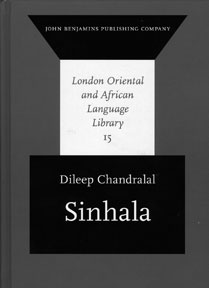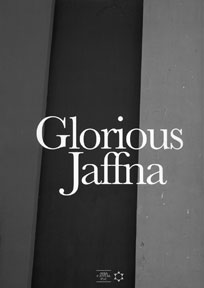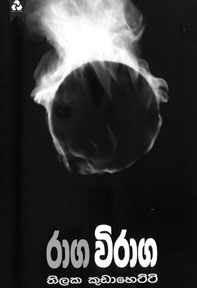|

Contrastive analysis of Japanese and Sinhala
Reviewed by Professor J. Tilakasiri
It is indeed a pleasant surprise and a cause for satisfaction to lay
my hand on the Sinhala language in a modern, innovative presentation to
respond to the academic and educational requirement of the study of
linguistics. A subject now popular among university courses.
The author, Dileep Chandralal, presently, the Professor of Language
and communication at Okinawa University has undertaken the valuable
publication, a reflection of the contrastive analysis of the structure
of Japanese and Sinhala to achieve his aim in research. His publication
shows the success of his work enabling him to offer 'a non-technical yet
highly informative account of Sinhala grammar in a clear and lucid
style' (as stated by Professor Masayoshi Shibatani in the Preface.)
 |
|
Author: Dileep
Chandralal
(John Benjamin Publishing Company) |
Learning grammar for mastering the language, Sinhala, in the
traditional manner is no longer necessary with the innovative aids and
resources provided through linguistic studies now provided making the
learning process more facilitating for beginners.
Students reading for higher degree courses in the subject should
indeed be thankful to Sri Lankan authors like Chandralal for this
methodical exposition of linguistics sharing the benefits of his
'journey in linguistics in the World of Sinhala'.
It must also be mentioned that the colloquial variety of Sinhala,
which is now very much mixed with selected vocabulary of Sanskrit when
the Sinhala word is not elegant and suggestive. The experience the
author has gained while being engaged in the study of Sanskrit and
Sinhala in the universities here, supplemented by the contrasting
analysis of the forms and equivalents, endows him with a necessary
qualification for bringing out this book. (Incidentally, I should
mention my experience of studying Japanese in an evening class in the
University in Colombo, where staff and students followed beginners
courses the glaring observation we could make, in the comparative
vocabulary and structures of sentences in both languages.)
It is to the credit of the Okinawa University teachers of the
language course that a simplified version of vocabulary and syntax etc,
had been used in teaching making it possible for the author to select
the data facilitating the comparative expressions.
While going through the methodical coordination of topics and use of
terminology in the well-printed text is a useful survey of the history
of the Sinhala language. The data given refers to the influences
exercised on the growth of the usages due to North Indian and later
Dravidian and even Portuguese and Dutch speech forms which entered into
the local speech at the spoken level.
The colloquial language of the native speakers have been using the
mixed forms of expression for conveying the ideas clearly.
It is on the basis of the historical background of Sinhala showing
the influences of foreign vocabulary that Sinhala developed two spoken
and written styles of writing. The classical literary form and the elite
style of expression were able to prevent the inclusion of a plethora of
unsuitable additions of erroneous material owing to the traditional
influences brought to bear on the writings of Sinhala writers and poets
of the early period producing literature of a high standard.
The book contains 13 chapters necessitating the introductory chapters
as preparatory access to the typology, phonology, morphology followed by
the structures of various constructions, sentences and grammatical
constructions (including pragmatics and grammar). These constitute the
structure and coverage of sub-topics dealt with easily understood
illustrations contributing to the comprehensive understanding of the
entire colloquial division of Sinhala, as understood today.
This publication, a highly commendable effort on the part of a
conscientious writer as serious studies and research on the division of
the Sinhala language with its mature literary heritage should be a
subject of essential research as the colloquial language can also lay
claim to recognition a standard form as much as the literary form in the
future.
Colloquial Sinhala would certainly become enriched and enter the main
stream of the language in both aspects in the years to come.
Linguistics is being studied in more than one university and along
with the diversification of Arts studies and the addition of new courses
Spoken Sinhala can lead not only to the enhancement of the language but
the enrichment of modern Sinhala literature, needing a development.
A peep into a distinctly preserved culture
by Thulasi Muttulingam
'Let's put a little bit of Jaffna into our lives' - that's how Asia
Capital PLC Chairman Manohan Nanayakkara put it when he launched a
coffee table book, titled 'Glorious Jaffna' as part of his company's CSR
initiative recently.
'Glorious Jaffna', is a very well laid out coffee table book with
photos by Tharindu Amunugama and descriptions by Sunela Samaranayake,
both employees of Asia Capital PLC.
 |
|
Glorious Jaffna
Authors: Tharindu Amunugama and Sunela Samaranayake |
"Ever since we can remember, Jaffna has been a place we could not
visit due to the civil war which devastated the peninsula and other
parts of the island for 26 years," notes Sunela in the company press
release. "As children we were told wonderful stories about Jaffna and
till very recently, they all seemed like fairy tales and bed time
stories of an amazing place. Therefore, it is with pride that Tharindu
and I have spent hours putting this book together - with the hope that
we can make those fairy tales come true in the eyes of our readers."
Indeed, anyone who has not been to Jaffna can get a very good idea
and feel of the place through this book. It has captured the essence and
spirit of Jaffna brilliantly. In the words of Tharindu, "This is a
tribute to a resilient people who have not lost hope."
The photos show weather worn and battle worn people, dusty roads,
broken buildings, ancient taxis....but an unbroken people.
When my mother went through the book, she said she felt nostalgic for
her hometown; the photos brought back memories. Her second observation
was, "Couldn't they have photographed some beautiful people? People
might think that Jaffna people are all dark and scrawny with weather
worn faces."
Take that observation with a pinch of salt, that was just her pride
in her people asserting itself and perhaps she felt a pang that some
heavily groomed and exotically finished products were not showcased, as
is typical in the media. I only bring it up to warn you that you will
not find any super models in this book. But I do not agree that they are
not 'beautiful!'
The typical Jaffna man or woman has not had the time or luxury to
worry about sun screens, facials and pedicures. Perhaps in time, when
they settle down to a life of peace and economic stability, that might
yet come but right now, they are still a people who have come out of a
terrible war and still have various obstacles to contend with.
Theirs are faces that speak of hardship and travails, not the
efficacy of expensive cosmetics and beauticians. Yet there is a singular
beauty about the old man with the bare gummed smile on page 67. Most of
his teeth have fallen out save for one remarkably protruding upper
tooth. Wildly grizzly eyebrows, stubbly face and one toothed grin; he
might not be anyone's idea of a model to endorse any products but he
could certainly be used as a model to endorse the saying, "Your smile is
your best beauty asset."
Determination, grit and friendly curiosity shine in the eyes of the
adults; Mischievousness, shyness or liveliness in those of the
youngsters.
The photos have brilliantly captured many and varied aspects of
Jaffna life - people visiting temples, temple structures and edifices,
tobacco cultivation, men fishing, women fish mongering, the old and
dilapidated palace of the last king of Jaffna, a broken down house in
the middle of nowhere, palmyrah trees standing tall, beggars squatting
outside a temple, men performing anga pradakshinam (fulfilment of vows
by lying flat on the ground and rolling round the temple premises), at
Nallur Kandasamy Temple. Within 160 pages, the book has captured the
people, the traditions, the culture and the landscapes of Jaffna
remarkably.
It is the kind of book that will bring pangs of nostalgia to people
who have lived and grown up there, memories to those who have visited
there and a window of opportunity to see what they have not yet been
able to see to those who have never been there.
"The culture and traditions of the people have stayed fixed in time"
observes Tharindu when asked what struck him about Jaffna on his first
trip there, adding that that is a good thing. In this globalised world
of T-shirts and jeans, McDonalds and Pizza Hut, Jaffna, cut off for so
long from outside influences, offers a window of opportunity to see a
distinctly preserved culture and a way of life.
He also listed the scenery and landscapes changing over short
distances and the friendliness, resilience and hope of the people
despite all they had been trough as aspects that had impressed him about
Jaffna.
And from Sunela: "I had heard so much about it and it lived up to all
my expectations. The people were so friendly and welcoming and I loved
the Jaffna food. It was awesome." She has included a recipe for the
famous Jaffna Kool (soup) in the book.
BOOK LAUNCH
Sinhalaye Ranahanda

Nimal Abhayawardhane's "Sinhalaye Ranahanda" was launched at
Dayawansa Jayakody Bookshop, Ven. S. Mahinda Mawatha, Colombo recently.
"Sinhalaye Ranahanda" is the authentic Sinhala translation of Collin
de Silva's "Winds of Sinhala."
The book is published by Dayawansa Jayakody Publishers.
Raga Viraga

Thilaka Kudahetti's latest Sinhala novel "Raga Viraga" will be
launched at Dayawansa Jayakody Bookshop, Ven. S. Mahinda Mawatha,
Colombo 10 on January 25 at 10 a.m.
Kudahetti is the author of several other books such as "Akala
Meghaya, Vathsunu Pavana, Durga Tharanaya, Neela Desa Pura, Kulagei
Vilanguva, Vathura, Bharatha Yogin Saha Isivarayin Samaga", and Bharatha
"Maha Rushi Ramana".
"Raga Viraga" is a Dayawansa Jayakody publication.
NEW ARRIVALS
Mithyadrushtikaya
(The Heretic)

Upali Ubayasekara’s Mithyadrushtikaya is a fiction based on the
incidents, that took place in Sri Lanka during the sixth century BC.
It is a Sooriya publication.
Anton Chekhov Gusef Lanka Gamana Thorathuru Vimasuma

Ranjana Devamithra Senasinghe’s Anton Chekhov’s Gusef Lanka Gamana
Thorathuru Vimasuma was launched in Colombo recently. It is a Sooriya
publication.
|

